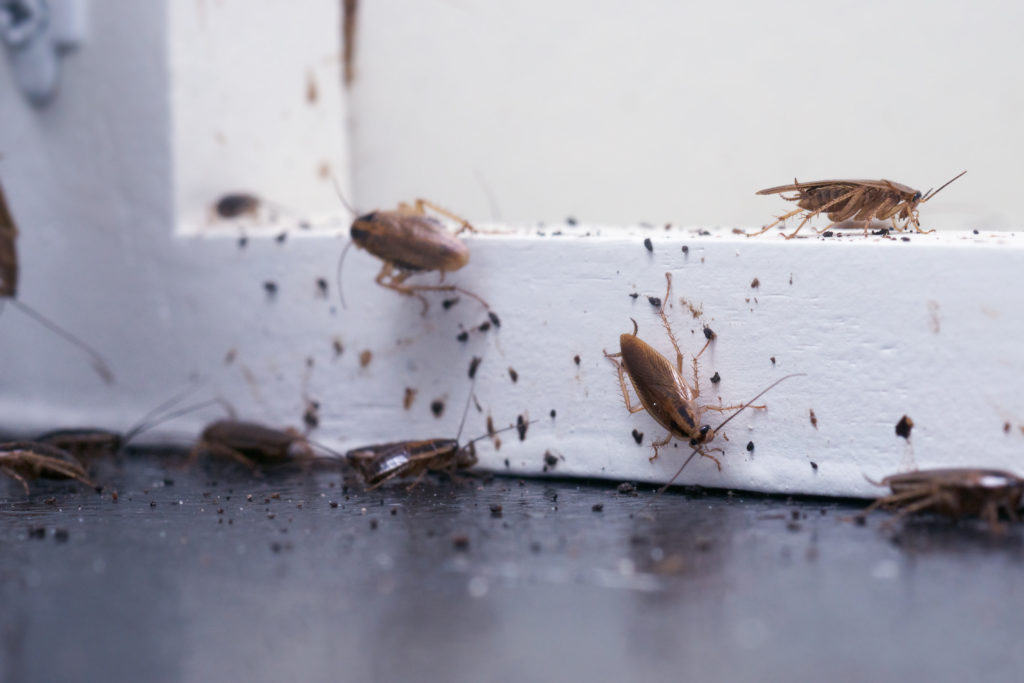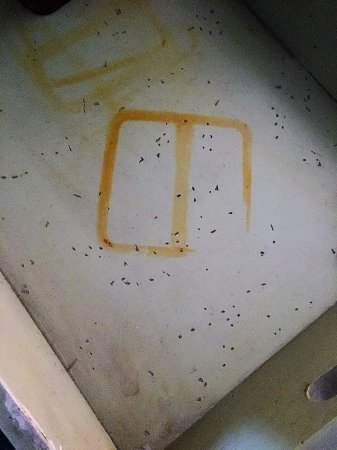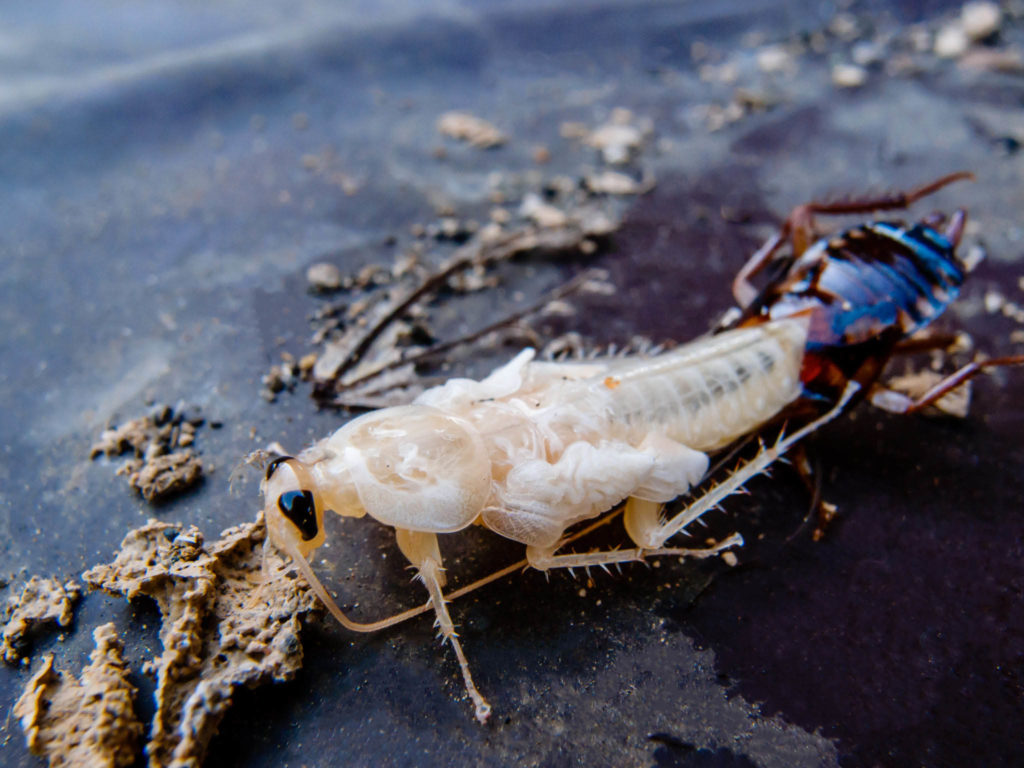You saw a cockroach crawling in your kitchen.
Now you’re worried that there’s more.
The good news is, seeing one roach doesn’t necessarily mean your house is infested.
But that doesn’t mean you should ignore it.
When you see a roach, you must take the necessary actions to determine if you have an infestation.
Here are seven signs that the roach you saw is just one of many.
1. You See a Cockroach During the Day
But lack of food resources and overcrowding can force them out of their hiding spots during the day.
If you spot a cockroach walking around during the day, it could be a sign that you are dealing with an infestation.
Do not take this lightly and take action immediately.
Some familiar cockroach hiding places in the kitchen include
I recommend laying out sticky traps where cockroaches tend to live and travel.
Household roaches love damp and dark places, so your kitchen and bathroom are great places to start.
Here are some ideal places for your trap:
- Under the kitchen and bathroom sink
- Inside, under and on top of Cabinets
- Under and behind appliances.
- Inside or behinds shelves
- Around the toilet
- In the bathtub
- Near or around drains
Check your traps daily.
If your trap has a few cockroaches with about the same size, your infestation is likely small and early.
On the other hand, if your sticky trap has many roaches with different sizes (adults, various sized nymphs, etc.), you’re dealing with a more significant infestation.
It may take a few days to get a good sample if you’re dealing with smaller infestations.
But, if you have a significant infestation, you’ll typically only need one day.
If you do not want to deal with sticky traps, you can also look at the locations mentioned above at night.
As mentioned, roaches are nocturnal and are much easier to find at night.
Grab a flashlight and look around familiar hiding places.
If you do spot roaches in these locations, you have an infestation and need to take immediate action.
2. Roach Droppings

Another key sign that you have an infestation is cockroach droppings.
Adult roach droppings will look like coffee grinds or ground pepper if you have a severe infestation.
Bigger roaches leave behind solid feces that are either black and brown with a cylindrical shape.
To differentiate large roach droppings from mouse droppings, look for ridges running from tip to tip.
If there are ridges, it’s a roach dropping.
Pay close attention and look in common hiding spots for droppings.
Used a flashlight to make the droppings stand out.
If you see droppings and stains, it’s a good indicator of an infestation.
3. Stains or Smear Marks

Juvenile roaches (nymphs) droppings look like a small grey, black, or yellowish stains.
Some adult feces can also look like stains or smears if repeatedly stomped on by other roaches.
If you find these stains and smears in your home, you are likely dealing with a full-blown roach infestation.
4. Cockroach Eggs

Another piece of evidence you can find are cockroach eggs and egg cases.
Roaches’ egg casings, called an ootheca, have a brown or reddish-brown color.
They are typically around 1/4 inch long.
Different species of roaches hide their ootheca differently.
While some carry the ootheca around, others hide them in a secure place.
These places are typically located where it’s dark, and food is easily accessible.
Female roaches will typically hide them in small crevices such as between cabinets and, sometimes, inside cardboard boxes.
Other types of roaches, such as the brown-banded cockroach, stick them to walls.
Be sure to look for eggs in areas you wouldn’t usually look like under kitchen cabinets or kitchen tables.
5. Unusual Smells
Another telltale sign is a strong, musty order in your home.
Many people compare this smell to an old refrigerator that has been unplugged for some time with feces’ addition.
The scent is most noticeable inside cabinets or under sinks where roaches have been hiding for some time.
This smell can be a serious indicator you have a roach problem on your hands.
They are likely nearby and are more than one.
6. Dead Roaches Lying Around
Dead roaches are not signs of an infestation dying off, but rather a sign of a growing population.
Roach carcasses is a sign that the cockroaches in your home have reached completed their lifecycle.
One female can lay between 8 and 10 ootheca or egg capsules in their short lifetimes.
That equates to 400 young.
It is likely that if one female cockroach reached full maturity, more have as well.
So, if you see cockroach carcasses, it is a strong sign that there is a more extensive infestation growing in your home.
7. Albino Roaches

As juvenile roaches (nymphs )grow, they go through a process called molting.
During molting, nymphs shed their exterior so that they can grow larger.
The result? White Roaches.
You’ll rarely see white roaches unless you have a severe infestation.
Roaches are vulnerable without their skeleton, so they’ll typically hide until their pigmentation is restored.
But white roaches can sometimes be forced outside their hiding place due to cockroach overcrowding.
8. Lose Body Parts and Skin Casings
If skin casings in your home, you likely have a growing infestation.
You may find these exoskeletons entirely intact.
But in some cases, you’ll find them in bits and pieces after other cockroaches have fed on them.
You’ll also see other cockroach body parts, such as bits of wings and antennae, in areas around your home.
That’s because roaches feed on each other’s carcasses
9. Property Damage

Cockroaches are scavengers and will eat anything from grease to fabrics.
If you see chew marks on your food packaging, wallpaper, books, and furniture around your home, this could be a sign of an infestation.
Another thing you can watch out for is damage to your electronics.
Both German roaches and brown-banded roaches love to hide in your electronics for warmth.
These pests can damage your electronics by leaving feces behind.
When it gets too hot, the feces can melt and cause eletronics to be short or its pieces to malfunction.
They will also feed on this insulation around your wiring and cause some significant electrical problems.
If cockroaches destroy your properties, that’s an undeniable sign that you have an infestation in your home.
10. Health Concerns, Allergic Reactions or Asthma
Roaches walk around filth and feces and easily spread bacteria and other pathogens in your home.
These bacteria can cause salmonella and infections such as staphylococcus and streptococcus.
According to the World Health Organization (WHO), cockroaches can also cause dysentery, diarrhea, cholera, and typhoid fever.
Another often overlooked side-effect of cockroaches is the allergic reactions they cause in human beings.
Research by the Asthma and Allergy Foundation (AAFA) has shown that the enzymes found in excrement, shedding body parts, eggs, and saliva can trigger both allergic reactions and asthma attacks.
If you suddenly experience these types of diseases or sicknesses, you may have a cockroach infestation, and your home is contaminated.
Where Do Cockroaches Live?
Different species of roaches will live in various places in your home.
The most common types of household cockroaches, American, German, and brown-banded cockroaches, are typically found in the kitchen or bathroom.
That’s because they love to be near their food and water sources.
There three roaches are the most worrisome types of cockroaches. They tend to infest homes and can reproduce very quickly.
What Should You Do if You Have Signs of an Infestation?
If you have seen one or more of the signs that your home has cockroaches, you must take immediate action.
For the best results, an integrated approach is the best way to eliminate roaches.
The best involves different types of bait and multiple control methods.
The first step to treating any cockroach infestation is to identify the type of roach you have.
Knowing what type of cockroach you’re dealing with will allow you to target specific areas where they live.
For instance, if you have American, German, and brown-banded cockroaches, you’ll want to treat your kitchen or bathroom.
If you have a wood cockroach, you’ll want to focus your efforts outdoors.
The best place to identify roaches is to place sticky traps under appliances on top or inside cabinets, under bathroom toilets, and near water sources.
I recommend placing around 6-8 traps around your house so you can determine the extent of your infestation.
Check your traps daily, typically during the day when roaches are less active.
It may take a few days to get a decent sample in smaller infestations, but with larger infestations, one day is typically enough.
Use your trap to get a good look at the cockroach.
Based on the type of roach you have and where they live, use the following methods:
- Apply Gel Bait, where the insects live and travel.
- Apply Dust Bait in small holes and crevices.
- Use packs of Insect Growth Regulators (IGR’s) to control the roaches population (these are like birth control to roaches)
- Seal all entry point around your house, including small holes on your walls, windows, and pipes. You’ll also want to seal the gaps on your doors and windows.
- Apply insecticide around your house for protection.
If you are in need some a detailed guide on how to treat cockroaches, read the articles listed below.
Cockroach Treatment Resources:
- How To Get Rid of Flying Cockroaches
- How To Get Rid Of American Cockroaches
- How to Get Rid of German Cockroaches
- How to Get Roaches Out of The Dishwasher
- How to Get Rid of Cockroaches Inside Electronics
- How to Get Rid of Cockroaches in Your Kitchen Cabinets
